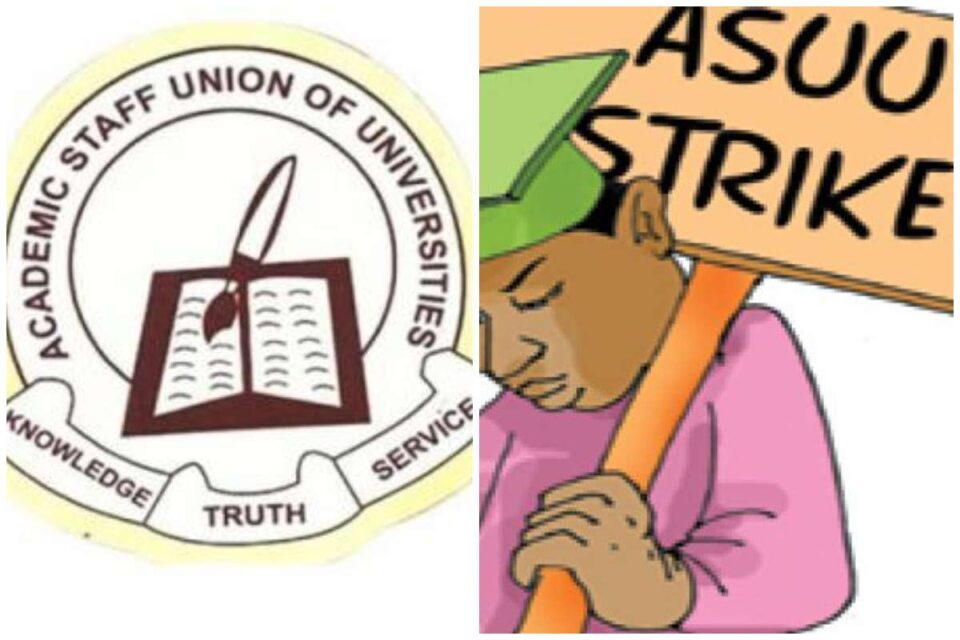By Prof. S.A.S. Aruwa
Higher educational Institutions (HEIs) are heading into a period of financial crisis. Now than ever, financing of HEIs in Nigeria have to be matched continuously with competing claims for the use of present and future resources. The current ASUU’s demands and funding requirements need to be appraised given the financing options in terms of sustainability of funding public universities.
Many developing countries, which fifteen years ago were spending only 1 to 2 per cent of their gross national product on education are today spending 3, 4 or 5 per cent. And whereas they were earlier spending less than 10 per cent of their total public budget on education, many are now spending 15, 20 or even 25 per cent. This rise in education’s share of national resources cannot go on at this rate indefinitely. The funding of education has not been up to 17% in any given year despite the UNESCO minimum standard of 26% of national budget. In Nigeria, according to Central Bank of Nigeria (CBN) statistical bulletin, public budgetary funding on education ranges between 4-13 percent.
In many countries, spending and revenue mobilisation by the government form a large portion of the nation’s total economic activity. The decisions to mobilise resources and allocate resources remain one of the most pervasive challenges among all levels of government. Yet, governments provide public goods such as roads, security, public utilities, education and health. In spite of the fact that public expenditure has increased rapidly in almost every country, and is spite of the growing importance of education, no significant funding has be made on education in Nigeria.
The pressing demands of other important public services and investments will increasingly put a brake on further expansion of education’s share. This means that sooner or later, in Nigeria, annual increments to education budgets will be forced into line with the growth rate of the economy and of public revenues as a whole. And if the economic growth rate is disappointingly low, the constraints on education budgets will be much more severe. While all this happens on the revenue side, however, the financial requirements of the university system will keep right on rising. The resulting disparity between the two is what sounds the financial crisis.
The reality of today’s public finance challenges is universal to all governments. The need to fund education and health are undoubtedly a productive priority for public spending. Nigeria like other developing countries, spend considerable resources on administration, economic services, social services and transfers. While these public expenditures are obviously fundamental to promote social, human and economic development, there are competing needs that governments must address. While issues of allocation efficiency of government resources is questionable particularly in developing countries, funding of essential social sectors must indeed be given priority.
The questions this article seek to address are:
Is ASUU’s demand rational?
Can the Federal Government of Nigeria (FGN) and States fund the ASUU’s demand sustainably?
What are the options for funding university education sustainably?
What is the way forward?
Is ASUU’s demand rational?
ASUU’s demand basically addresses the welfare of academics and the provision of conducive environment for learning. These issues are not only germane but necessary conditions for effective learning and teaching. Comparatively with other countries of the world, the welfare of staff can best be described as poor. Yes, the infrastructures and environment of learning and teaching have improved courtesy of Tertiary Education Trust fund (TETFUND) interventions.
Some issues need to be critically examined. Why the mounting earned allowance claims? Why must ASUU allow members to take excess load? Certainly the excess load regime has undermined work productivity and academic research output. I disagree with mainstreaming of excess academic allowance, it should not exist at all. We should seek appropriate intervention in recruitment of academics into the university system and create the enabling employment for teaming qualified graduates. I also don’t agree that with pay parity arguments. After all, in Nigeria, the private and public universities are paying differently. Universities should be allowed to negotiate their pays above existing academic remuneration. ASUU must accept this reality and allow mobility of academics based on pay structure. While academic remuneration are better than that of the civil servants, it is however far less compared to political office holders, government agencies and private sector pay structures. I don’t see the basis of comparison. Labour’s wage and salaries vary based on salient factors.
The FGN Integrated Personnel Payroll Information system (IPPIS) has brought sanity to payroll administration in Nigeria. However, IPPIS has created distortions in the payroll of academics in federal universities, which made ASUU to reject it. ASUU has a point here based on peculiarities of the universities and this can be addressed without so much disagreement. Unfortunately, government has neither accepted this reality of modifying IPPIS or accepting the solution proffered by ASUU through deployment of the updated University Transparency and Accountability Solution (UTAS) in spite the National Information Technology Development Agency (NITDA) approval.
ASUU’s grouse on non-release of revitalisation fund and accumulated promotion arrears are understandable. The Ad-hoc response of government budgetary provisions to meeting these obligations is worrisome. ASUU also complained on the proliferation of State universities by State governments who have failed to adequately fund existing ones. I believe strongly that we need more universities, perhaps, self-funding universities to give access to underserved applicants. This funding challenge should spur stakeholders to seek alternative funding mechanism for the universities rather than shutting admission opportunities.
My take is that ASUU should be part of the solutions to these problems. After all, ASUU recommended TETFUND model that has saved our public universities of infrastructural decay and UTAS for addressing unique university system needs. What’s wrong with our strategy today is that we put forward several demands without helping to advocate the solutions. Academics must contribute to finding solutions than resorting to industrial strike. I disagree with strikes, it fails to address our problems but compounds the growing challenges facing higher institutions in Nigeria. We must rethink and suggest the ways forward.
Can the FGN and States fund the ASUU’s demand sustainably?
The model of public funding of higher educational institutions in Nigeria has been called to question. University education system has rising demands on budget size of FGN and States. Obviously, governments have failed consistently to meet global minimum standard for funding education sector. The reason is obvious. Government revenues have declined in the face of rising defense funding, debt servicing, and infrastructural needs. There is a fiscal challenge. Simply put it, government cannot continuously meet its university funding obligations today and for future generations. Sustainable funding is almost uncertain. I agree, a lot of wastes in governance, missed priority and lack of allocative efficiency.
Given the magnitude of corruption in government and in public universities, we cannot continue to have government funding universities. By my critical assessments of our universities, we have litany of financial recklessness, revenue leakage, and procurement frauds. We must work to eliminate these and save resources for the system. Government must be seen to be sincere in entering into agreements. Government has failed in her commitment to 2009 ASUU agreement and implementation of MOUs and MOAs. Government has also not put forward solutions to lingering university disputes but grand standing on lack of funds to meet demand. We are yet to see any genuine proposals from government towards resolving ASUU demands.
Government agencies should establish their funding difficulty and provide the options for addressing the issues raised by ASUU. Government has indeed failed to satisfactorily address all the issues raised in the 2009 FGN-ASUU agreement.
What are the options for funding university education sustainably?
The take-off point strategy for coping with the financial crisis is for university authorities to find out more than they have ever had to know before on the economic facts of life of their university system. To see the future more clearly, they must first find out how the system got where it is today, financially. What shifts have been occurring, for example, in where the money comes from, and in where it goes? Do these trends need to be reversed if possible, such as, for instance, the characteristic trend toward heavier dependence of education upon government revenues, with less and less support coming from internal and private sources? Likewise, they need to find out what has been happening to their unit costs. Has the composition been changing? Have increasing academic costs crowded out essential expenditures for other vital university needs, without which even the best academics are severely handicapped and their productivity reduced? If unit costs have been rising at various points in the system, what have been the main causes, and to what extent can the rise be countered?
We need to find sustainable ways to fund public universities. Some of such sustainable strategies is through the adoption endowments, cost-sharing, community funding, and alumni (graduate) tax options, which have successfully established in the Western world and will take little or nothing to implement in our environment. These sources have been grossly underutilised in our clime.
There are many other options available for addressing university funding. Admittedly, the infrastructural development is been adequately handled by the education tax model. An option is to undertake a critical assessment of the funding portfolio of TETFUND. The need to devise strategies for expanding the funds rather than the current ‘collect and share’ approach. The allocation priority of the fund should begin to change to address infrastructural maintenance and recurrent needs of the universities. Again, it’s wrong to maintain same allocation priorities for all the public universities irrespective of their needs.
The options for funding recurrent expenditure must be worked out with all honesty. We have the option of charging affordable tuition needed for each university without emphasis on uniform fees. This way, real financial autonomy of our institutions will be assured. We can also adopt a 50:50 internal/external funding of recurrent expenditures. This will require universities to generate 50% of their recurrent internally.
The way forward
The current challenges of the university system require collaborative and cooperative efforts of government and ASUU. Whereas urgent action is needed on the part of government, the reconstituted committee is expected to ‘renegotiate in realistic and workable terms the 2009 agreements with other University-Based Unions; negotiate and recommend any other issue the Committee deems relevant to reposition the Nigerian University System for global competitiveness and submit proposed draft agreements within three (3) months from the date of inauguration.” The committee should work round the clock and beat the period to avoid worsening the situation.
ASUU’s demand must be balanced with reality and workable in the light of economic realities in Nigeria. Certainly, the FGN and States cannot fund the ASUU’s demand sustainably. Government and the universities must therefore, come up with options for funding university education sustainably. Some State Universities in Nigeria are already on self-funding model, this may be a sustainable plan. The pull of funds with TETFUND has expanded, fund investments initiatives and new fund allocation models and priorities are now demanded. There is need to rethink the model to focus on current needs and realities of the universities based on age and level of development and devise a sound project management system that gives absolute value for money.
I suggest that both parties should put forward realistic strategic solutions to addressing the issues raised by ASUU. We must build a common interest in the development of the university system. All stakeholders have interests and responsibilities. Our students must not suffer because of government’s failure and ASUU’s strike. The window for rebuilding trust exists and ASUU and other unions must be prepared to deal with reality and come up with workable terms to addressing the issues genuinely. At the end, a win-win outcome will benefit all.
Prof. S.A.S. Aruwa is a Professor of Accounting & Finance, Member of Governing Councils of Nasarawa State University, Keffi and ANAN University, Kwall.



